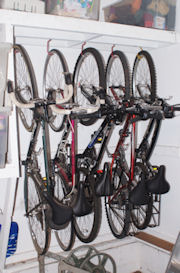
No lack of bicycles in the Bacon household -- 1.7 bikes per person. But there's nowhere in Henrico County to ride them. Provide connectivity between subdivisions and there would be.
by James A. Bacon
Last week Richmond Times-Dispatch Publisher Tom Silvestri asked in a commentary what plans local governments had to make their communities more bicycle friendly. The City of Richmond and County of Henrico responded. Here’s the bottom line: By the year 2015 Richmond plans to have 140 miles of dedicated bike lanes and “sharrows” (bike lanes sharing streets with cars). Henrico County will have only 16 miles of “multi-use trails paralleling major roadways,” of which 15 miles will consist of Henrico’s portion of the Virginia Capital Trail linking Richmond and Williamsburg, a statewide initiative. Otherwise, the county will have one mile on North Gayton Road.
I am embarrassed for my home county, which otherwise tends to be a desirable place to live. When Chesterfield County is more progressive on the subject of bike lanes than we are, that’s quite an indictment.
It would oversimplify grotesquely to attribute Henrico’s inhospitality toward self-propelled transportation simply to retrograde thinking. Peruse the comments in response to Henrico’s 2025 Comprehensive Plan and you’ll find many Henrico residents demanding more attention be paid to the bicycling alternative. “The County is too far behind in the development of bicycle paths and bike lanes,” said one George Talley in a fairly typical response. “Bicycling needs to be considered as a mode of transportation as an alternative to motor vehicles.”
However, there is no organized constituency in Henrico County for bicycles because very few Henricans (or whatever we call ourselves) use bicycles for utility travel, which includes commuting and running errands. The reason seldom use bicycles for utility travel is that Henrico’s development pattern of segregated and low-density land uses pushes destinations far apart. Thus, it would be impractical than in Richmond to choose bicycle travel as a means of conveyance even if bike paths ran along every major road.
Functionally, bikes and bicycle trails are regarded in Henrico as a form of “recreation,” hence a lower priority in the competition for county investment than “transportation.” If Henrico plowed significant dollars into building traditional bicycle trails, there are legitimate reasons to question whether people would use them for utility trips. The return on dollar invested would be terrible.
The county already has dozens (perhaps hundreds) of miles of mostly empty sidewalks. Judging by their attire, the only people who use them are recreational walkers. Why would bicycle trails be any different? In dire fiscal times, we cannot afford the luxury of building bike trails that no one uses.
Contrast the situation in Henrico with the City of Richmond. Virginia Commonwealth University, situated just on the edge of downtown, estimates that there are 14,000 bikers on campus, according to Richmond BizSense. In recognition of the widespread bicycle use, VCU is spending $100,000 on a bike-maintenance and education building, which it will call the RamBikes stand. The service will include a program in which students can check out a bike for a day just like they would a library book.
Richmond land use patterns are compact. Travelers can reach for more destinations within the same amount of biking time than they could in Henrico. Urban streets have much lower speed limits, making it less intimidating to ride in the city. Moreover, bikable streets in the city create a functional network. Building a few miles of scattered, unconnected bike trails in Henrico county would not create a viable transportation alternative. Perhaps most important, those 14,000 VCU students represent a large and coherent constituency for pro-bicycle policies in the city, for which there is no counterpart in the county.
Bacon’s brilliant solution. Henrico County does have one advantage over the city: untold miles of lightly traveled subdivision roads and streets. Subdivision streets are broad and mostly empty — ideal for bicycle travel. The problem is, they go nowhere. Due to Henrico’s penchant for developing sub divisions in disconnected pods, a cyclist could not travel far without hitting a heavily traveled and bicycle-hostile arterial road. (Try riding on Patterson Ave. with cars whooshing by at 45 to 50 m.p.h. I have tried it once. I won’t again!)
A possible solution is to connect pod subdivisions with bicycle rights of way. Expenditures would be minimal — acquisition of perhaps 10-foot-wide right-of-way across a single piece of property (most likely between two pieces of property), and construction of a short path linking subdivision streets. Suburbanites like their cul de sacs because they prevent cars from cutting through, creating a danger for children. It’s hard to imagine that bicycles would inspire the same objection.
For a very modest price, Henrico could connect ten or twelve subdivisions per year in most compactly settled areas of the county (bordering the city, for the most part) and start creating a bicycle network for a fraction of the cost of building parallel bike paths or re-engineering existing roads as sharrows. As a practical matter, destinations would remain distant and scattered. But at least they would be connected, and some destinations would be within cycling distance. The price tag would be so low that there would be little to lose. It’s worth a try.


